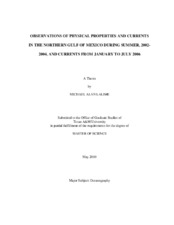| dc.description.abstract | Many processes in the ocean are interrelated. The direction with which an eddy rotates will determine if nutrients are moved closer to the surface where they can be utilized by plankton to increase the base of the food chain, or it can restrict growth by causing the surface layer of nutrient poor water to deepen below the photic layer. The direction of current flow will also affect the temperature structure, which is a contributing factor in the density of water. A change in density can act as a barrier between the surface and deeper waters, effectively isolating the surface from deep waters. It is important to understand the physical properties in a study area in order to understand the dynamics controlling the distributions of nutrients, which influence the distribution of plankton, which influences the distribution of predator species like squid and whales. The Sperm Whale Seismic Study (SWSS) tracked the locations of sperm whales in the Gulf of Mexico. This study seeks to describe the physical environment in which they live.
To that end, various physical properties observed during the SWSS cruises were processed and used in conjunction with sea surface height (SSH) fields from satellite altimetry data. The data from different years and from the same years are used to provide descriptions of the physical environment present during the SWSS cruises and how that environment changed between cruises. A time-series of currents, collected over a six month time period in 2006, is included to document how the currents are influenced by different processes found along the continental slope in the northern Gulf of Mexico.
The findings indicate the observed currents are related to local SSH features. Temperature structure can be influenced throughout the upper 1000 m by these SSH features. The temperature structure is stable over time but depends on local SSH features. Properties nearer to the surface are more variable than at depth. Although the overlying wind field most likely influences the currents at 51 m no correlation between winds observed at the Brutus platform and currents observed at 51 m at the Ocean Star platform was found. | en |


